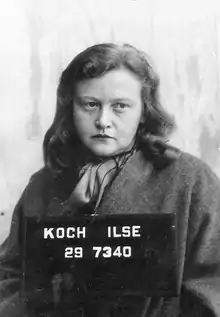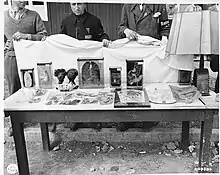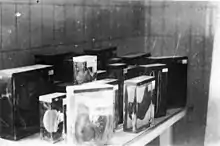Ilse Koch
Ilse Koch (22 September 1906 – 1 September 1967) was married to Karl-Otto Koch, commandant of the Nazi concentration camps Buchenwald (1937–1941) and Majdanek (1941–1943). In 1947, she became one of the first prominent Nazis tried by the U.S. military.
Ilse Koch | |
|---|---|
 Koch in c. 1947 | |
| Born | Margarete Ilse Köhler 22 September 1906 |
| Died | 1 September 1967 (aged 60) Aichach, West Germany |
| Nationality | Nazi Germany |
| Other names | The Bitch of Buchenwald The Witch of Buchenwald |
| Known for |
|
| Spouse(s) | |
| Children | 4 |
| Conviction(s) | A charge of incitement to murder a charge of incitement to attempted murder five charges of incitement to severe physical abuse of prisoners and two charges of physical abuse. |
| Criminal penalty | sentenced to life imprisonment with forced labor in the Aichach women's prison.[1] |
After the trial received worldwide media attention, survivors' accounts of her actions resulted in other authors describing her abuse of prisoners as sadistic, and the image of her as "the concentration camp murderess" was current in post-war German society.[2]
She was accused of taking souvenirs from the skin of murdered inmates with distinctive tattoos, although those claims were rejected at both of her trials. She was known as "The Witch of Buchenwald" (Die Hexe von Buchenwald) by the inmates because of her cruelty and lasciviousness toward prisoners. In English, she is referred to as: "The Beast of Buchenwald",[3] "Queen of Buchenwald",[4][5] "Red Witch of Buchenwald",[6][7] "Butcher Widow",[8] and more commonly, "The Bitch of Buchenwald".[9]
Early life
Koch was born Margarete Ilse Köhler in Dresden, Germany, the daughter of a former military commander. She was known as a polite and happy child in her elementary school. At the age of 15, she entered an accountancy school. Later, she entered employment as a bookkeeping clerk. At the time the economy of Germany had not yet recovered from defeat in World War I. In 1932, she became a member of the Nazi Party. Through some friends in the SA and SS, she met her future husband, Karl-Otto Koch, in 1934.


In 1936, she began working as a guard and secretary at the Sachsenhausen concentration camp near Berlin, where her fiancé was the Commandant. The couple married the same year. In 1937, her husband was posted to Buchenwald.[10]
War crimes
While at Buchenwald, Koch allegedly engaged in gruesome experiments; selected tattooed prisoners were murdered and skinned to retrieve the tattooed parts of their bodies.[11] This was allegedly done to help a prison doctor, Erich Wagner, in his dissertation on tattooing and criminality.[12]
In 1940, she built an indoor sports arena, which cost over 250,000 reichsmarks (approximately $62,500), most of which had been seized from the inmates. In 1941, Karl-Otto Koch was transferred to Lublin, where he helped establish the Majdanek concentration and extermination camp. Ilse Koch remained at Buchenwald until 24 August 1943, when she and her husband were arrested on the orders of Josias von Waldeck-Pyrmont, SS and Police Leader for Weimar, who had supervisory authority over Buchenwald. The charges against the Kochs comprised private enrichment, embezzlement, and the murder of prisoners to prevent them from giving testimony.[13]
Ilse Koch was imprisoned until 1944 when she was acquitted for lack of evidence. Her husband was found guilty and sentenced to death by an SS court in Munich, and was executed by firing squad on 5 April 1945 in the court of the camp he once commanded. She then lived with her surviving family in the town of Ludwigsburg, where she was arrested by U.S. authorities on 30 June 1945.
First trial

Koch and 30 other accused were arraigned before the American military court at Dachau (General Military Government Court for the Trial of War Criminals) in 1947. Prosecuting her was future United States Court of Claims Judge Robert L. Kunzig. She was charged with "participating in a criminal plan for aiding, abetting and participating in the murders at Buchenwald".[14]
Koch stated in the courtroom that she was eight months pregnant but on 19 August 1947, she was sentenced to life imprisonment for "violation of the laws and customs of war".[15]
Reduction of sentence
Gen. Lucius D. Clay, then interim military governor of the American Zone in Germany, reduced the judgment to four years' imprisonment on 8 June 1948, after she had served two years of her sentence, on the grounds that "there was no convincing evidence that she had selected inmates for extermination in order to secure tattooed skins, or that she possessed any articles made of human skin".[16] The reduction of the sentence resulted in an uproar, when it was made public on 16 September 1948, but Clay stood firm by his decision.[17] Years later Clay stated:
There was absolutely no evidence in the trial transcript, other than she was a rather loathsome creature, that would support the death sentence. I suppose I received more abuse for that than for anything else I did in Germany. Some reporter had called her the "Bitch of Buchenwald", had written that she had lamp shades made of human skin in her house. And that was introduced in court, where it was absolutely proven that the lampshades were made out of goat skin. In addition to that, her crimes were primarily against the German people; they were not war crimes against American or Allied prisoners ... Later she was tried by a German court for her crimes and sentenced to life imprisonment. But they had clear jurisdiction. We did not.[17]
The Buchenwald Memorial Foundation states that:
For the existence of a lampshade from human skin there are two credible witnesses who made statements under oath: Dr. Gustav Wegerer, Austrian, political prisoner, kapo of the infirmary, and Josef Ackermann, a political prisoner and secretary of the camp doctor Waldemar Hoven.
- Wegerer explained: "One day at about the same time 1941 the camp commandant Koch and the SS doctor Müller appeared at my work command in the infirmary. At that time a lampshade made of tanned, tattooed human skin was being prepared for Koch. Koch and Müller chose among the available tanned, parchment-thin human skins the ones with suitable tattoos, for the lampshade. From the conversation between the two it became clear that the previously chosen motifs had not pleased Ilse Koch. The lampshade was then completed and handed over to Koch." Dr. Hans Mueller, later SS physician in Obersalzberg, was a pathologist in Buchenwald from March 1941 to April 1942. The time period can be defined more precisely through Ackermann's statement.
- Ackermann delivered the lamp, as he testified in 1950 in court. The lamp-foot was made from a human foot and shinbone; on the shade one saw tattoos and even nipples. On the occasion of the birthday party of Koch August 1941 he was tasked by the camp doctor Hoven to bring the lamp to the Kochs' villa. This he did. One of the party guests told him later that the presentation of the lamp had been a huge success. The lamp immediately disappeared after the SS leadership learned about it. Ilse Koch could not be accused of making the lampshade.[18]
Second trial
Under the pressure of public opinion, Koch was re-arrested in 1949 and tried before a West German court. The hearing opened on 27 November 1950 before the District Court at Augsburg and lasted seven weeks, during which 250 witnesses were heard, including 50 for the defense. Koch collapsed and had to be carried from the court in late December 1950,[16] and again on 11 January 1951.[19] At least four witnesses for the prosecution testified that they had seen Koch choose tattooed prisoners, who were then killed, or had seen or been involved in the process of making human-skin lampshades from tattooed skin.[16] However, this charge was dropped by the prosecution when they could not prove lampshades or any other items were actually made from human skin.[20]
On 15 January 1951, the Court pronounced its verdict, in a 111-page-long decision, for which Koch was not present in court.[20] It was concluded that the previous trials in 1944 and 1947 were not a bar to proceedings under the principle of ne bis in idem, as at the 1944 trial Koch had only been charged with receiving, while in 1947 she had been accused of crimes against foreigners after 1 September 1939, and not with crimes against humanity of which Germans and Austrians had been defendants both before and after that date. She was convicted of charges of incitement to murder, incitement to attempted murder and incitement to the crime of committing grievous bodily harm, and on 15 January 1951 was sentenced to life imprisonment and permanent forfeiture of civil rights.[21]
On 10 May 1950 Koch was indicted by Dr. Hans Ilkow, chief prosecutor at the superior court in Augsburg. On 15 June 1951, Koch officially started her life imprisonment sentence.[22] Koch appealed to have the judgment quashed, but the appeal was dismissed on 22 April 1952 by the Federal Court of Justice. She later made several petitions for a pardon, all of which were rejected by the Bavarian Ministry of Justice. Koch protested her life sentence, to no avail, to the International Human Rights Commission.[23]
Family
Karl and Ilse Koch had one son and two daughters. Their son committed suicide after the war "because he couldn't live with the shame of the crimes of his parents."[23] Another son, Uwe,[24] conceived in her prison cell at Dachau with a fellow German prisoner,[25] was born in the Aichach prison near Dachau where Koch was sent to serve her life sentence and was immediately taken from her. At the age of 19, Uwe Köhler[26] learned that Koch was his mother and began visiting her regularly at Aichach.[25]
Suicide
Koch hanged herself[27] at Aichach women's prison on 1 September 1967 at age 60.[28] She suffered from delusions and had become convinced that concentration camp survivors would abuse her in her cell.[29]
In 1971, her son Uwe sought posthumous rehabilitation for his mother. Via the press, he used clemency documents from her former lawyer in 1957 and his impression of her based on their relationship in an attempt to change people's attitude towards Koch.[25]
In popular culture
- Woody Guthrie wrote "Ilsa Koch", a song about her abuses in Buchenwald, her imprisonment and release; it was recorded by The Klezmatics.
- Koch was the inspiration for a series of Nazi exploitation films,[30] such as Ilsa, She Wolf of the SS (1975).
- The British label Come Organisation released a noise music compilation Für Ilse Koch (wdc881021) in 1982 featuring bands Nurse with Wound, Consumer Electronics, Etat Brut, Club Moral (wrongly listed as "Wiking DDV"), Whitehouse and others.[31]
- Koch's life inspired the movie The Bitch of Buchenwald directed by Gerry Malir and narrated by Peter Morgan Jones. The documentary was released in 2009 to detail the life and crimes of Ilse Koch. It includes embezzlement, sadism, and humanity crimes.[32]
- There were numerous books written, including the limited series The Buchenwald trilogy. The very first of the series, titled The Beasts of Buchenwald: Karl & Ilse Koch, Human-skin Lampshades, and the War-crimes Trial of the Century, explored official crimes, accusations, as well as life outside of the concentration camps for Ilse and Karl Koch.[33]
See also
- Female guards in Nazi concentration camps
- Irma Grese
- Phil Lamason, the senior officer in charge of 168 allied airmen taken to Buchenwald
- Maria Mandl
- Aribert Heim
References
- History.com Editors (5 November 2009). "The "Witch of Buchenwald" is sentenced to prison". History.com. A&E Television Networks. Retrieved 20 April 2020.
- Przyrembel, Alexandra (October 2001). "Transfixed by an Image: Ilse Koch, the 'Kommandeuse of Buchenwald'". German History. Blackwell Publishing Ltd. 19 (3): 369–99. doi:10.1191/026635501680193915. ISSN 1477-089X. (subscription required)
- Alban, Dan (10 November 2005). "Books Bound in Human Skin; Lampshade Myth?". Harvard Law Record. Retrieved 22 September 2008.
- Boyle, Hal (14 August 1947). "Cruel 'Queen of Buchenwald' given a permanent address". The Milwaukee Journal. p. 2. Retrieved 16 December 2012.
- "Buchenwald Queen must face German court on release". The Evening Independent. 4 July 1949. p. 15. Retrieved 16 December 2012.
- "Ilse Koch, Red Witch of Buchenwald, on Trial". Los Angeles Times. 28 November 1950. p. 5. Retrieved 16 December 2012. (subscription required)
- "Life sentence for 'Red Witch' of Buchenwald". Lewiston Evening Journal. 15 January 1951. p. 6. Retrieved 16 December 2012.
- "Army seeks new charges against butcher widow". The Evening Independent. 29 September 1948. p. 3. Retrieved 16 December 2012.
- William L. Shirer (1990). The Rise and Fall of the Third Reich (3rd ed.). New York: Simon & Schuster. p. 885.
- "The Holocaust Chronicle". 1937: Quiet Before the Storm. Holocaustchronicle.org. p. 117. Retrieved 7 June 2011.
- Mittelbau-Dora, Stiftung Gedenkstätte Buchenwald und. "Lampenschirme aus Menschenhaut? – Gedenkstätte Buchenwald". buchenwald.de.
- "The most evil women in history". Discovery Channel, 2001.
- Höhne, Heinz (2000). The Order of the Death's Head: A History of the SS. Penguin Books. ISBN 9780141390123. The author notes the irony that the SS prosecutor, Konrad Morgen, investigated some cover-up murders of inmates in detail while being ignorant of, or willfully ignoring, the industrialized mass murder in the camps further to the east.
- Encyclopedia of the Third Reich. New York: Macmillan. 1991. p. 43.
- Yearbook of the European Convention on Human Rights. 5. Martinus Nijhoff Publishers. 1963. pp. 126–136. ISBN 978-90-247-0949-6.
- "GERMANY: Very Special Present". Time. 25 December 1950. (subscription required)
- Jean Edward Smith, Lucius D. Clay: An American Life.
- ""Stimmt es, dass die SS im KZ Buchenwald Lampenschirme aus Menschenhaut anfertigen ließ?" – Beantwortet von Dr. Harry Stein, Kustos". buchenwald.de (in German). Retrieved 27 February 2020.
- "Woman decides against suicide Life demanded for Ilse Koch". The Spokesman-Review. 12 January 1951. p. 2. Retrieved 16 December 2012.
- "Ilse Koch is given life term". Gettysburg Times. 15 January 1951. p. 2. Retrieved 16 December 2012.
- Smith, Arthur Lee (1994). Die Hexe von Buchenwald: der Fall Ilse Koch (in German). Böhlau Verlag. p. 146. ISBN 978-3-412-10693-5.
- Koessler, Maximilian (1 January 1958). "ILSE Koch Senate Investigation and Its Legal Problems with Observations on Double Jeopardy and Res Judicata, The". Missouri Law Review. 23 (1). ISSN 0026-6604.
- "Ilse Koch on trial at Dachau for making human lamp shades at Buchenwald". www.scrapbookpages.com.
- "Fun Trivia: N : Nazi Germany: Children of the Nazis". funtrivia.com. Archived from the original on 11 June 2015. Retrieved 23 January 2016.
- Binder, David (7 May 1971). "Ilse Koch's Posthumous Rehabilitation Sought by Son". The New York Times. New York. Retrieved 18 March 2018.
- "Koch, Ilse". World War II Graves. Retrieved 23 January 2016.
- Norman Polmar, Thomas B. Allen: World War II: the Encyclopedia of the War Years, 1941–1945, Publisher Courier Corporation, 2012, ISBN 9780486479620 p. 476
- Hackett, David A. The Buchenwald Report [Bericht über das Konzentrationslager Buchenwald bei Weimar]. pp. 43, n. 19, 3.
- Nikolas Wachsmann, 'KL: A History of the Nazi Concentration Camps' (New York: F, S & G, 2015), p. 618, citing a Feb. 1967 note in her prison file.
- Ryan M Niemiec, Danny Wedding: Positive Psychology at the Movies: Using Films to Build Virtues and Character Strengths, Publisher Hogrefe Publishing, 2013 ISBN 9781616764432, p. 209
- "come organisation records". Retrieved 3 February 2013.
- Malir, Gerry (28 July 2009). "The Bitch of Buchenwald". www.amazon.com. ASIN B0026LYME6. Retrieved 29 April 2020.
- Whitlock, Flint (2011). The Beasts of Buchenwald: Karl & Ilse Koch, Human-skin Lampshades, and the War-crimes Trial of the Century (The Buchenwald Trilogy Book 1). Amazon. ASIN B004USOOXM.
Sources
- Massimiliano, Livi (2008). "Ilse Koch". In Pugliese, Elizabeth; Hufford, Larry (eds.). War Crimes and Trials: A Historical Encyclopedia, from 1850 to the Present. Santa Barbara: ABC-CLIO. ISBN 9781576078907.
- Gutman, Israel, ed. (1995). Encyclopedia of the Holocaust. Macmillan. pp. 809–810. ISBN 9780028645285.
- Lacqueur, Walter; Baumel, Judith Tydor, eds. (2001). The Holocaust Encyclopedia. Yale University Press. p. 97. ISBN 9780300084320.
- Shirer, William L. (1990) [1959]. The Rise and Fall of the Third Reich. Simon and Schuster. pp. 983–984. ISBN 9780671728687.
External links
 Media related to Ilse Koch at Wikimedia Commons
Media related to Ilse Koch at Wikimedia Commons- "Ilse Koch". Jewish Virtual Library.
- "Frau Ilse Koch, General Lucius Clay, and Human-Skin Atrocities". Jewish Virtual Library.
- Adams, Cecil (4 June 2004). "Did the Nazis make lampshades out of human skin?". The Straight Dope.
- Ilse Koch (1906–1967) (dailymotion). The Most Evil Women in History. Discovery Channel. Retrieved 17 March 2017.
- Newspaper clippings about Ilse Koch in the 20th Century Press Archives of the ZBW
